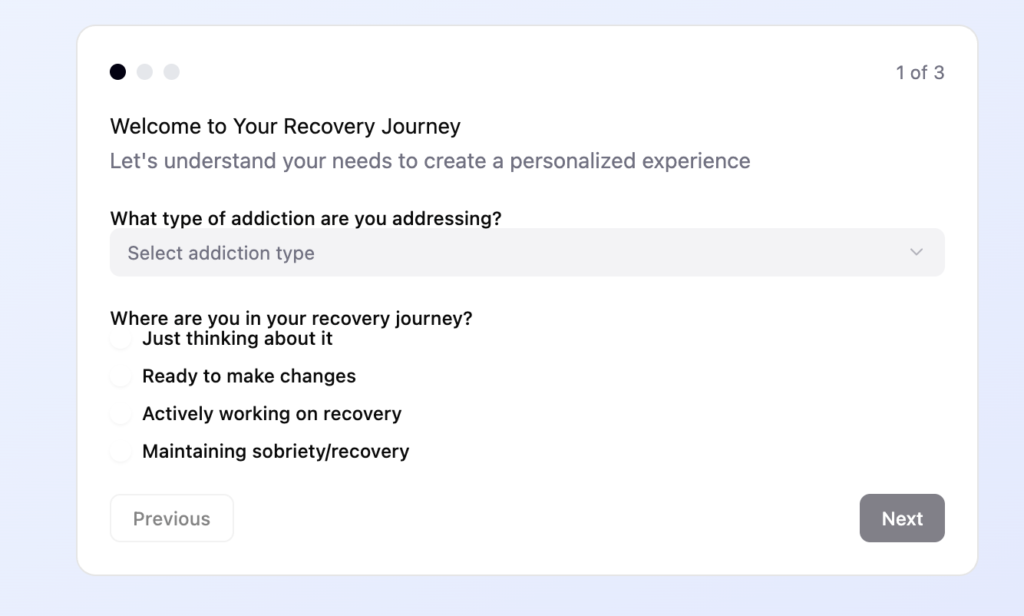How a mobile app can “support—not pressure”—people on the path to healing
Introduction
I’m not pretending to cure the world with a mobile app. But over the past 20 years, I’ve accumulated experience in UX design for various industries including healthcare and worked closely with professionals helping people overcome addiction. These insights, thoughts, and questions have long been circling in my mind—and it’s time to bring them out.
This article is a starting point, not a final framework. I hope it may resonate with someone who shares the same vision and wants to take it further, perhaps even build a product together.
Starting Point
Let’s begin with a few key ideas that shape the approach:
- The goal is to support the person, not pressure them to quit.
- Addiction has multiple dimensions: spiritual, physical, and social.
- Some people want to stop the consequences of their usage, not the use itself.
- It’s about progress, not perfection.
- Support, not substitution, is often the missing piece.

The Concept
Understanding the Person
Before offering help, we need to understand what the person actually wants.
That’s why onboarding becomes not just a UX step, but a diagnostic stage.
Here we can use clinically-proven questionnaires to evaluate:
- The severity of the addiction
- The user’s level of motivation
- Available time and resources
Example onboarding questions:
- On a scale from 0 to 10, how much do you want to get healthier?
- How much time can you dedicate each day to recovery?
- How strongly do you believe this app can help you? (0–10)
Based on this, we personalize the first steps of the journey.

The Three Layers of Recovery
1. Spiritual Layer
Goal: help users reconnect with their inner self, uncover personal truths, and gain perspective.
Tools & Features
- Guided meditations (audio/video)
- Breathing practices
- Reflective quizzes
Access should be effortless: daily routines, push notifications, and automation can lower the friction for engagement.
2. Physical Layer
Goal: increase awareness of the addiction’s physiological effects and offer healthier alternatives.
Tools & Features
- Educational videos explaining how addiction works
- Motivational interviews with professionals
- Physical training programs (beginner level)
- Nutrition and food supplements (optional, but contextual)
3. Social Layer
Goal: make the user feel supported and connected, but not isolated.
Tools & Features
- Online/offline meetings
- Peer-to-peer messaging
- Local events and support groups
- Community board/forum
- Success stories from others
These features can be made available progressively, respecting user boundaries and readiness.
Flow: Turning Experience into Structure
Principle: Time protects
The less unstructured time a person has, the less room there is for relapse.
That’s why the daily structure becomes a central UX and recovery element.
Step-by-step user flow:
1. Install the app & onboarding (FTU)
The app evaluates severity, motivation, and time available.
2. Dashboard is generated
Based on available time, the user receives a personalized, manageable set of daily tasks and content.
Each task is tied to one of the three dimensions:
- Spiritual (meditation, quiz)
- Physical (walk, light exercise, video)
- Social (read a story, comment in forum)
3. Daily routine
- The app integrates with the calendar (optional)
- Suggests 1–3 “healthy slots” during free time
- Encourages creating a simple schedule
- Asks for alarm clock access (to prompt positive action from the morning)
“Wake up at 7:00 > watch a motivational video > walk 3,000 steps > reflect for 3 mins.”
4. Progressive personalization
Instead of asking 50 questions on Day 1, we space them across the first 10 days:
| Day | Questions (examples) |
|---|---|
| 1 | Severity, goals, available time |
| 3 | Marital status, kids, pets, age group |
| 5 | Job type, working hours, hobbies |
| 7 | Personality style, favorite books |
| 9 | Previous treatment history (if any) |
Each step unlocks new content and updates the personalized program.
Tracking & Reflection
We don’t punish relapse, we learn from it.
- Green days: no use, completed tasks
- Neutral days: some effort, partial success
- Slip days: reflection appears automatically
After a relapse, the user gets a short questionnaire to identify:
- Triggers
- Emotional state
- Time of day
- Social context
The system then gives specific advice:
“Hey John, based on your recent experience, we suggest limiting high-risk events like parties. Remember: staying well means more energy for your kids and work.”
Motivational feedback should also highlight health improvements:
- Day 1 without alcohol: your liver just took its first step toward healing.
- Day 365: you’ve likely added a full year to your life.
With good UI and visual design, this kind of progress is deeply motivational.
Connection Before Monetization
This project is human work first, technology second.
The app should encourage:
- Human-led meetings
- Mentor roles for sober users
- Voluntary contact sharing with others
- Encouragement to join offline communities
Rewards can be given for:
- Supporting others
- Participating in meetings
- Logging consistently
Monetization
The app itself is free and content-rich.
Revenue can come from:
- Books
- Supplements
- Consultations with therapists and coaches
- Voluntary donations
- Advertising from relevant clinics (if ethical)
Final Flow Summary
- User installs the app
- FTU onboarding defines time and needs
- Dashboard suggests first content/tasks
- User completes activities, content unlocks gradually
- Daily check-in and reflection
- Alarm integration prompts morning action
- New questions gradually personalize the plan
- Calendar and habits tracked visually
- Community opens up with progress
- Real-world support is integrated
Closing Thought
Designing for addiction recovery isn’t about screens, buttons, or sales tactics.
It’s about empathy, pacing, and human connection.
We’re not replacing therapists.
We’re building the bridge between intention and action.
If you feel aligned with this thinking – reach out.
Let’s build something that helps someone take their next step.These features can be made available progressively, respecting user boundaries and readiness.